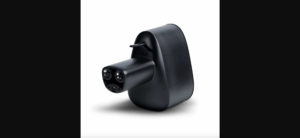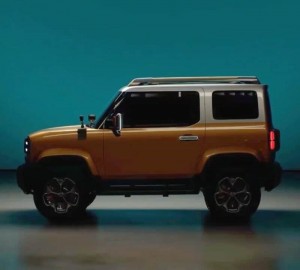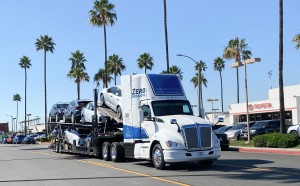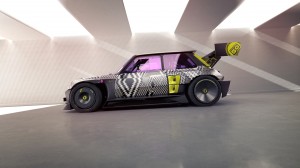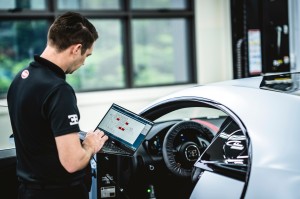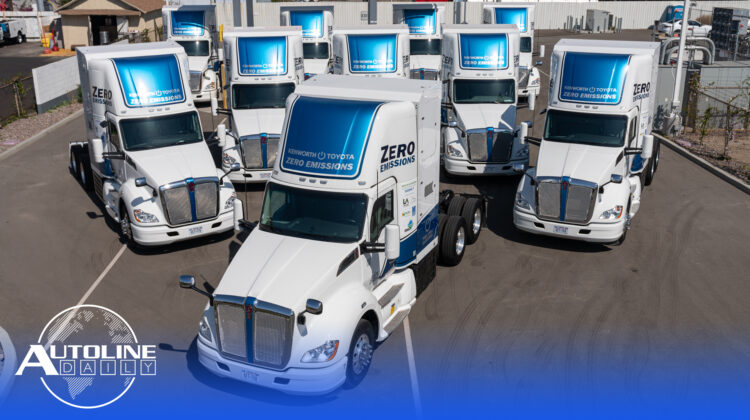
Listen to “AD #3411 – GM Steps Up Battery Recycling; Tesla Sells $250 CCS Adapter; Toyota Says Fuel Cells Ready to Replace Diesels” on Spreaker.
Follow us on social media:
Runtime: 11:33
0:00 GM Steps Up EV Battery Recycling
0:54 Tesla Sells $250 CCS Adapter
1:42 BNEF Predicts Big Surge in Electrification
3:01 Baojun’s Cute EVs
4:03 Mercedes Unveils Monster AMG C-Class
5:14 Toyota Says Fuel Cells Ready to Replace Diesels
5:57 EPA Wants Tougher Big Truck Regs
7:27 Renault’s Electric R5 Pocket Rocket
8:44 Volvo EX90 Flagship is All Electric
9:44 Bugatti Launches Certified Pre-Owned Program
Visit our sponsors to thank them for their support of Autoline Daily: Bridgestone, Intrepid Control Systems, MEDC and Schaeffler.
This is Autoline Daily, the show dedicated to enthusiasts of the global automotive industry.
GM STEPS UP EV BATTERY RECYCLING
EV battery recycling just took another step forward. GM is investing in a company called Lithion which will recycle materials from old batteries to produce new ones. Lithion, which is based in Montreal, says it can recover 95% of the materials in an old battery and with Quebec’s green hydro energy, its operations reduce greenhouse gas emissions by over 75% and water usage by over 90% compared to mining new materials. Lithion will start operating next year and its facility will have the capacity to recycle 7,500 metric tons per year. It also plans to open facilities in the U.S., Europe and South Korea.
TESLA SELLS $250 CCS ADAPTER
So far Tesla seems to be the only company that knows how to build out a large network of reliable EV chargers. But even Tesla Superchargers aren’t everywhere, so to help Tesla owners use any public EV charger it’s offering customers a CCS adaptor, which costs $250. But the adapter doesn’t work with older Teslas so the company suggests that owners log into their Tesla account to see if their car is compatible. Tesla has hinted it might open up its Supercharger network to non-Tesla owners in the U.S. But so far that hasn’t happened. One thing we’ve got to point out: look how big and clunky the CCS plug looks next to the Tesla one.
BNEF PREDICTS BIG SURGE IN ELECTRIFICATION
Legacy automakers have been surprised that customer demand for EVs is coming in stronger than expected. And now a new report from Bloomberg New Energy Finance says electrified vehicle sales, including PHEVs, in the U.S. will soar by the end of the decade. It predicts they’ll account for more than half of new car sales by 2030. Previously, it forecasted electrified vehicles would reach 43% of sales by that time. Bloomberg believes the tax credits in the new Inflation Reduction Act will speed up adoption, since they’ll be at the point of sale which means buyers get the discount immediately instead of waiting to get the credit when filing their taxes.
BAOJUN’S CUTE EVs
GM’s subsidiary in China called Baojun is coming out with some really cool looking electric cars. This cute little 4×4 is branded the KIWI but we don’t really know if that’s the name of the vehicle, or a new brand name for a lineup of electrics under the Baojun brand. Last week Baojun unveiled this little electric commuter car, also branded KiWi. The commuter car has a rear mounted electric motor with either 54 or 68 horsepower, and the 4×4 will have a motor in the rear and the front. But that’s about all we know so far. Baojun is an interesting brand. Over a decade ago the Chinese government asked foreign automakers to create a Chinese brand with cars completely designed and developed in China by Chinese engineers. General Motors was about the only foreign automaker to do it, and that’s how the Baojun brand was born.
MERCEDES UNVEILS MONSTER AMG C-CLASS
At the opposite end of the product spectrum, Mercedes unveiled the AMG version of the C-class, officially called the C 63 E Performance. It’s a hybrid, with a combined 680 horsepower. 470 of those horses come from a turbo-4 and 210 horses come from a two-speed electric motor mounted on the rear axle. Interestingly, the electric motor is powered by a 400 volt battery developed in-house by AMG. Mercedes says the turbo-4 uses Formula One inspired electric assist for the turbo to eliminate turbo lag. The engine develops an amazing 238 horsepower per liter. All this power will rocket the car from 0 to 100 kilometers an hour in 3.4 seconds. Some other notable features: there’s a drift mode that will lock up the rear tires, there’s rear steering, and for the first time ever, the AMG badge is on the hood, not the Mercedes three pointed star.
TOYOTA SAYS FUEL CELLS READY TO REPLACE DIESELS
Toyota says it proved that fuel cells can replace diesels in big trucks. It just wrapped up its real-world test of fuel-cell semis at the ports of Los Angeles and Long Beach.The Class 8 semi-trucks were built by Kenworth and Toyota provided the fuel cell system. They have a range of 300 plus miles when fully loaded to 82,000 pounds. The trucks were able to run multiple shifts a day and cover 400 to 500 miles. Toyota says they reduced greenhouse gas emissions by nearly 75 metric tons of CO2 per truck annually compared to the diesel-powered ones. And all this presumably paves the way to put fuel cell trucks into production.
EPA WANTS TOUGHER BIG TRUCK REGS
And in related news, Reuters reports that the U.S. Environmental Protection Agency wants to ratchet up greenhouse gas emission regulations for heavy-duty trucks. With the passage of the Inflation Reduction Act, which provides a up to a $40,000 tax credit for medium and heavy-duty electric trucks, the EPA wants to reduce CO2 emissions from big trucks by 25% for model years 2027 to 2029 and it plans to finalize the rules in December.
RENAULT’S ELECTRIC R5 POCKET ROCKET
Renault wanted to demonstrate that electric cars can be a blast to drive, so it created the R5 Turbo 3E concept. It’s sort of a reinterpretation of Renault 5 Turbo 2, but this one features a completely tubular frame with carbon fiber body panels. It’s also all-electric. Two electric motors that drive the rear wheels combine for 280 kW or 380 horsepower and help propel the car from 0-100 km/h in 3.5 seconds. The R5 Turbo 3E is surprisingly light for an electric. It weighs 980 kilograms or a little over 2,150 pounds but more than half of that comes from its 42 kWh battery pack. A reason to keep weight so low is to improve performance and handling as Renault sees this as a real drift king, which is helped made evident by the huge drift lever in the center console. Who knows if we’ll ever see anything like this in production, but the R5 Turbo 3E will be available in video games and as a series of NFTs.
VOLVO EX90 FLAGSHIP IS ALL ELECTRIC
Volvo is going to reveal the next-generation of its flagship SUV on November 9th, which will now be fully electric and called the EX90. In the lead up to its debut, Volvo is showcasing some of the technology we can expect to see. It says the EX90’s ADAS system will have one of the most advanced sensor sets on the market. Lidar will be standard and its crash prevention system also includes 8 cameras, 5 radar and 16 ultrasonic sensors. With this system Volvo believes it can reduce severe accidents by 20%. Another piece of tech is a driver understanding system. Not only does it use multiple sensors to make sure the driver is paying attention, but it can also detect if they’re stressed, drowsy or impaired and the vehicle will be able to take action if need be.
BUGATTI OFFERS PRE-OWNED PROGRAM
Buying a used vehicle can be a roll of the dice, you never really know what you’re going to get. It’s one reason certified pre-owned vehicles are popular. You know they’ve gone through a multi-point inspection of the most critical parts. We can only imagine this is even more important for someone spending millions on a vehicle. Bugatti just launched a certified pre-owned program for the Veyron and Chiron. Not only will a customer know the vehicle has been looked over completely, they get a one-year limited warranty that covers all mechanical and electrical items as well as the cost of parts and labor. When a used Veyron still costs over a million bucks and a Chiron two to three times that, it’s probably a good idea to have it checked out first.
KUNISKIS ON AAH
What’s it going to take to get hard-core piston-heads with gasoline running through their veins to switch over to electric muscle cars. Can it even be done? That’s what we’re going to be asking Tim Kuniskis this afternoon. The head of Dodge will be on Autoline After Hours and if you’d like to pose a question to him, post it below or send it to viewermail@autoline.tv. We’ll go live at 3 pm eastern time and this promises to be one raucous show.
But that’s a wrap for today’s show. Thanks for tuning in.
Thanks to our partner for embedding Autoline Daily on its website: WardsAuto.com
Seamus and Sean McElroy cover the latest news in the automotive industry for Autoline Daily.




